SOLVING SOLVING BINOMIAL EQUATIONS INDIA
algebra square cube roots interactive lessons,
math equations percent algebra formulas,
sat prep formulas square root ,
factorization fraction quadratic equations equation ,
partial differential equation solution first order linear ,
calculating a 3rd order polynomial with one variable ,
Algebra expressions, what is the difference between evaluation and simplification of an expression? ,
Algebra help with factoring sums of cubes ,
why use factoring to solve quadratic equations ,
Algebra, what are the difference between evaluation and simplification of an expression,
substitution method is easier than the addition method when one of the equations is very simple and can readily be solved for one of the variables ,
free solving equations with fractional coefficients help,
cube root calculator TI-83 plus how to do,
online algebra calculator square root,
simultaneous linear equation in two variable for class ten ,
ti-89 convert number base 6 to number base 3 ,
simplifying radicals absolute value ,
algebraic equation with fractional exponent ,
ti 83 plus factoring complex number,
algebra linear equations graphing worksheet ,
addition and subtraction of fractions worksheets lcd,
java examples to find the number & sum of integers divisible by 7 ,
multiplication division rational expressions problem solvers,
java code convert mixed fraction to decimal ,
algebra square root solver,
free answers for comparing linear combination methods for solving systems of equation in a chart ,
square root revision for calculator common entrance ,
charts and graph on the comparison of substitution and linear combination ,
how to solve a 2nd order differential equations ,
quadratic formula square root method ,
solve quadratic equation for the specified variable,
maple solve nonlinear multivariable two equations problems examples ,
free Algebra calculator for Rational Expression ,
addition and subtraction formulas solved problems
Thank you for visiting our site! You landed on this page because you entered a search term similar to this: solving solving binomial equations india, here's the result:
| Europeans Prior To Pascal
Who Knew About The Triangle |
Blaise Pascal was not the first man in Europe to study the binomial coefficients, and never claimed to be such; indeed, both Blaise Pascal and his father Etienne had been in correspondence with Father Marin Mersenne, who published a book with a table of binomial coefficients in 1636. Many authors discussed the ideas with respect to expansions of binomials, answers to combinatorial problems and figurate numbers, numbers relating to figures such as triangles, squares, tetrahedra and pyramids.
Here is a short list in chronolgical order of publishing.
Ancient Greek Era
Until recently, little had been known of the Greeks interest in combinatorics; it was known that they studied square numbers and triangular numbers, the second column of the Triangle,
Recently a lost manuscript of Archimedes was rediscovered in a palimpsest, a text written over another older text. Archimedes' work was bleached out and the parchment was cut to make paper for a prayerbook about 1000 years ago. Using modern techniques, the work Archimedes did was restored, and it was shown he had correctly figured out the number of different ways a geometric puzzle called the Stomachion could be reassembled into a square; while Archimedes does not use the binomial coefficients, it does show an interest in counting previously unseen in surving texts from the classical Greek period.
The First Millenium (from 0 to 1000 A.D.)
Circa 100 A.D.: Two authors, Theon of Smyrna and Nicomachus of Gerasa, saw that the sum of triangles could be seen as a tetrahedron, so the tetrahedral numbers, the third column of the Triangle,
275: Porphyry correctly lists the number of pairs of five voices is not 5×4=20, but 5×4/2=10. His work is a commentary on Aristotle's Categories.
320: Pappus of Alexandra generalizes Porphyry's work.
Circa 510: Boethius, writing a commentary on Porphyry's work, repeats the generalization found by Pappus.
10th Century A.D.: Sortes Apostolorum published, a book of fortune telling by dice rolls. Similar publications, including 1484's Libro della Ventura are the impetus for Tartaglia solving the general problem of how many different dice rolls there are given k dice, each with n sides.
The Second Millenium (from 1000 A.D. until Pascal)
1140: In Spain, Rabbi Ben Ezra figures out the seventh row of the Triangle, in connection with the question of how to take the Sun and the six known planets (Mercury, Venus, Earth, Mars, Jupiter and Saturn) in combinations of one at a time, two at a time, etc.
1202: Fibonacci (also known as Leonardo of Pisa) writes down the expansion of (a+b)3, which was already well-known in India and the Middle East. Besides being know for the Fibonacci numbers, he is also credited with being the first European mathematician to use the Hindu-Arabic numerals we use today, which made the Roman numeral system obsolete.
Circa 1225: Jordanus of Nemore, a German mathematician, in his manuscript de Arithmetica shows that he understands both
13th Century, exact date unknown: In a poem entitled de Vetula, it is shown that three six-sided dice can come up in 56 different ways, if we count 6-6-5 to be the same as 6-5-6 and 5-6-6, for example.
1321: Levi Ben Gerson, a Frenchman came up with the falling factorial formula for the binomial coefficients, and presents the first known examples of an explicit mathematical induction proof. Both Ben Gerson and Ben Ezra were interested in the Hebrew mystical tradition of the Cabala, which has an interest in, among other things, seemingly magical relationships between numbers.
Circa 1407: an edition of Jordanus' de Arithmetica contains the following table.
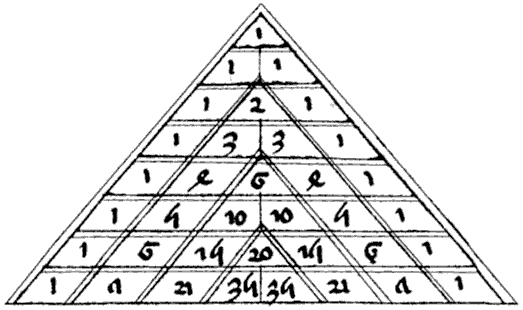 |
| Note the somewhat strange obsolete versions
of the numerals 4, 5, 6 and 7, while 0, 1, 2 and 3 are easily
recognizable in their modern form. |
1484: Lorenzo Spirto's Libro della Ventura (Book of Fortune) lists the 56 ways 3 six-sided dice can be thrown in nearly exactly the same way described in the poem de Vetula from two centuries before. This is the inspiration for Tartaglia to solve the general problem for k dice, each with n sides in 1523, which is
1523: Nicolo Tartaglia first publishes the generalization of the figurate numbers. Some 30 years later, in his General Treatise, he publishes the Triangle in table form. Tartaglia is the first mathematician to publish a general formula for solving cubic equations. His name in Italian means "stammerer". This cruel nickname was given to him after severe facial wounds he suffered at the age of twelve when attacked by a soldier invading his hometown of Brescia nearly killed him; these wounds left him able to speak only with difficulty for the rest of his life.
1539: Gerolamo Cardano, the Italian algebraist, correctly determines that the number of ways to take 2 or more things from a set of n things is 2n-n-1, which is the sum of the nth row of the Triangle if we ignore the first two entries.
1544: The German mathematician Michael Stifel publishes the extended Figurate Triangle in the figure shown below. Stifel gives credit to Cardano's work published five years earlier.
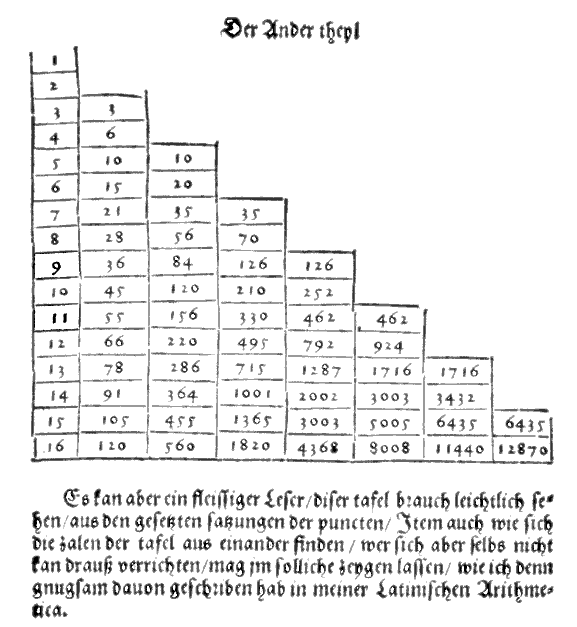 |
| To turn this into Pascal's Triangle,
we would need to add a column of 1's at the beginning, and then mirror
the numbers listed on the left onto the right side, except for the
rightmost entry in the even rows and the two rightmost entries in the
odd rows. |
1545: Scheubelius, another German, publishes his version of the Triangle in connection with the extraction of roots, the great unsolved problem of the age in its most general form.
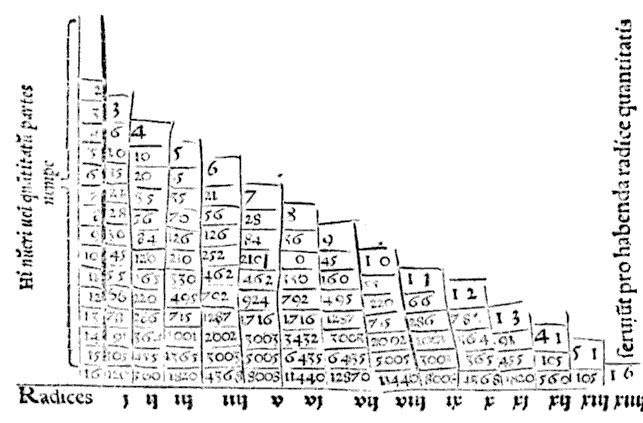 |
| Not as neat as Stifel's work a year earlier,
and with the obvious errors of "41" and "51" at the end of rows 14 and
15 (there's also a "0" in row 10 that should be 120), Scheubelius'
work does show that the Triangle is symmetric, which isn't clear in
Stifel's representation. |
1556: Tartaglia publishes his General Treatise, which includes the following tables of the Triangle
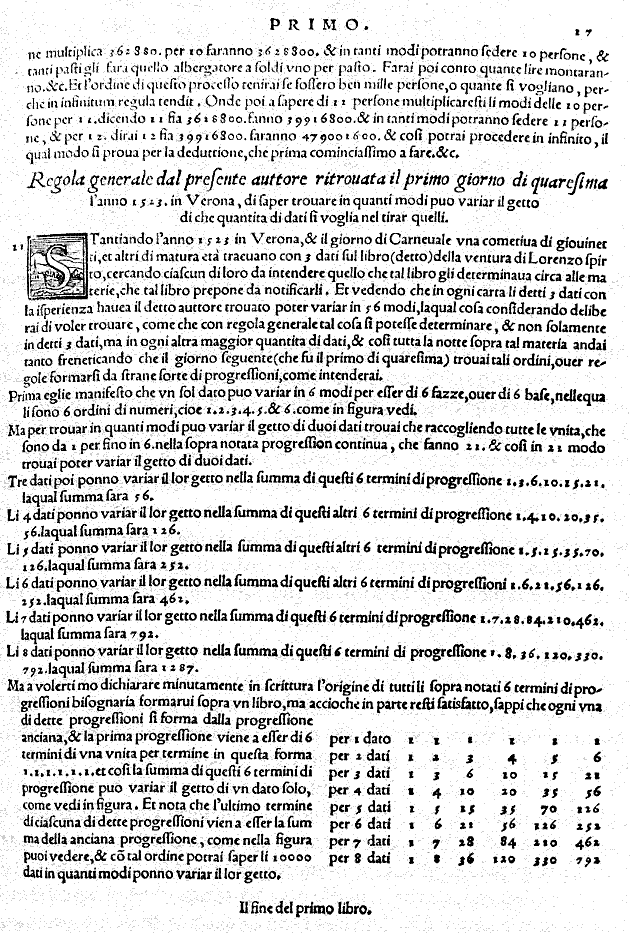 |
| The first page of Tartaglia's General
Treatise, with the Triangle written in rectangular form |
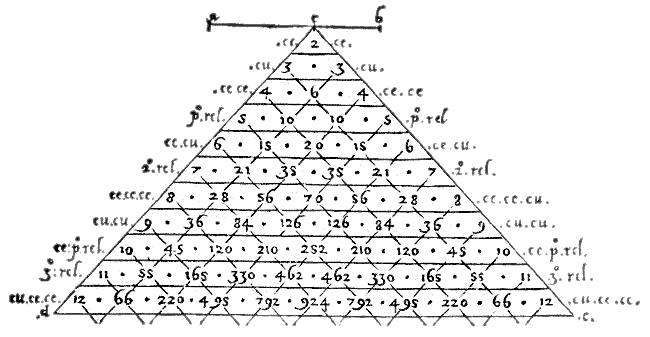 |
| Also from Tartaglia, the Triangle in
symmetric form, with the 1's removed from both left and right |
1570: Cardano publishes his Opus Novum (New Work), which includes the following page.
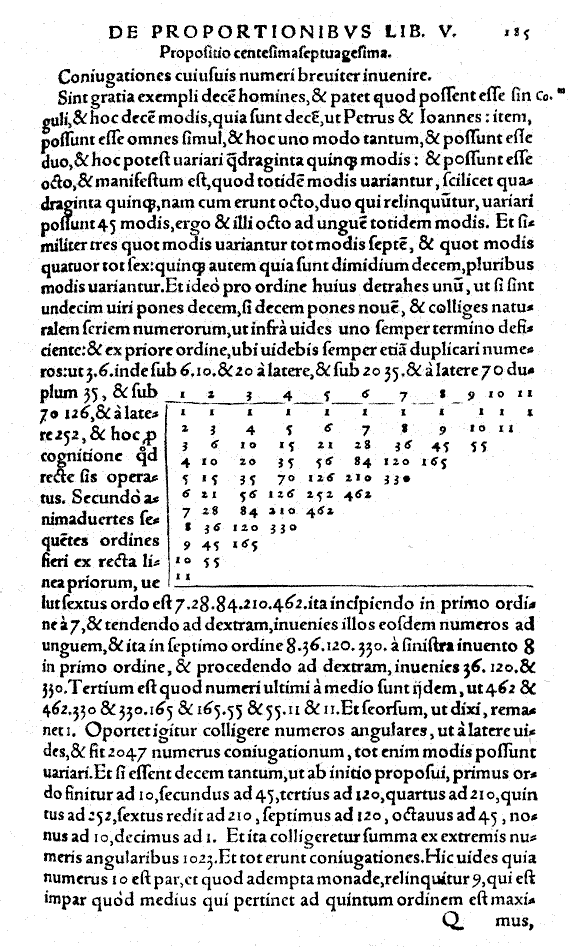 |
| Cardano's 1570 work, which states the
figurate numbers are the combinatorial numbers |
1591: François Viète gives names to the first few columns of the Triangle in Latin; "numeri trianguli", "pyramidales", "triangulo-trianguli", "triangulo-pyramidales" These names are also used in the next century by Pierre de Fermat, who was Pascal's main correspondent in solving the Problem of Points, and William Oughtred, a British mathematician who influences many of his countrymen who come after him.
1631: William Oughtred publishes his Clavis Mathematicae, which influences his student John Wallis and is later owned in a 3rd edition printing ; both Wallis and Newton are instrumental in the work that connects the binomial coefficients to the new field of calculus later in this century.
1633: The lifetime work of Henry Briggs entitled Trigonometria Britannica is published two years after his death by his friend Henry Gellibrand; he has a chapter on the figurate numbers, which he refers to as "the calcuator of many uses".
1636: Father Marin Mersenne publishes his Harmonicorum Libri XII; Mersenne in his life meets with both Blaise Pascal and his father Etienne, and there is little doubt both of them read the book and saw this table.
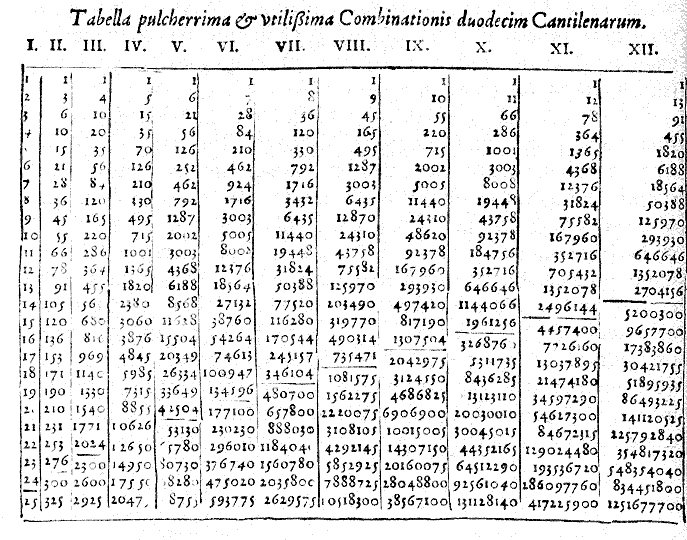 |
| While missing the first row of 1's, this
table does correctly show that "36 choose 12", the number in the lowest
right hand position, is over 1.2 trillion, a remarkable feat of
patience for a person calculating all these numbers by hand. |